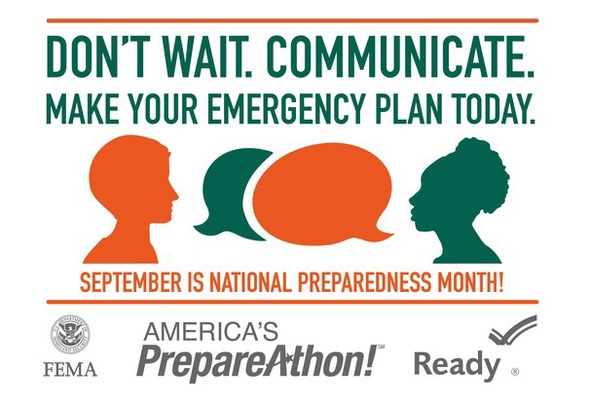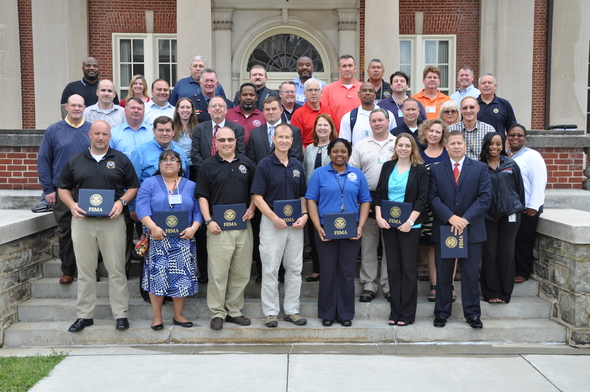|
Each year, September is recognized as National Preparedness Month, which serves as a call to action to prepare, now and throughout the year, for the types of emergencies that could affect us where we live, work, and visit.
This year’s National Preparedness Month theme is “Don’t Wait. Communicate. Make Your Emergency Plan Today.” Don’t wait! Make a plan with your family and friends for how you will stay safe and communicate during an emergency or disaster that can affect your community. Download the Family Communication Plan for Parents and Kids and fill out the sections before printing or emailing it to your family and friends.
The themes for four of the five weeks in September raise awareness about disasters including floods, wildfires, hurricanes, and power outages. The themes call attention to emergencies and disasters that could happen across the country this time of year. The fifth week leads up to National PrepareAthon! Day on September 30, when the nation will come together to take action and practice their preparedness in advance of an emergency.
Download the digital toolkit and become involved with
promoting National Preparedness Month by visiting www.ready.gov/september. More information about National Preparedness Month will be included in September editions of the External Affairs Bulletin.

FEMA
congratulates the 41 students who graduated from the National Emergency
Management Basic Academy on August 20, 2015.These students completed the
full curriculum which provides the basic knowledge and skills to
help meet the unpredictable challenges in the field of emergency
management. Graduates represented emergency management professionals from
federal, state, local, tribal and territorial governments and the private
sector.
FEMA’s National Emergency Management
Basic Academy is the entry-point for individuals pursuing a career in emergency
management, offering the tools to develop the needed comprehensive
foundational skills. For those who are new
to emergency management, the Basic Academy also provides a unique opportunity
to build camaraderie, to establish professional contacts, and to understand the
roles, responsibilities, and legal boundaries associated with emergency
management.
The
Basic Academy is the first of a three-level Academy series in the Emergency
Management Professional Program (EMPP). The
EMPP curriculum is designed to guide and educate emergency management
professionals as they progress through their careers, providing a lifetime of
learning. The EMPP includes three separate,
but closely threaded, training programs; building from the Basic Academy; to
the National Emergency Management Advanced Academy, and culminating in the
National Emergency Management Executive Academy. The Advanced Academy is a
program to develop the next generation of emergency management leaders who are
trained in advanced concepts and issues, advanced leadership and management,
and critical thinking and problem solving. The Executive Academy is
a program designed to challenge and enhance the talents of the nation’s
emergency management senior executives through critical thinking, visionary
strategic planning, challenging conventional
concepts, and negotiation and conflict resolution applied to complex
real-world problems.
Emergency management professionals should visit www.training.fema.gov/empp
for more information
about which academy best suits their needs.
Congratulations, graduates!

As college students head back to school, take a
moment to talk with them about fire safety. Each year, on-and off-campus college and university
students have hundreds of fire emergencies. Most of these fires are caused by
smoking materials and cooking. The United States Fire Administration (USFA) suggests the following campus fire safety tips:
When cooking:
- Cook only where it is permitted.
- Keep cooking area clean and uncluttered.
- Keep an eye on what's being cooked, especially
if cooking at high temperatures.
- If a fire starts in a microwave, keep the door
closed and unplug the unit.
If smoking:
- Make sure cigarettes and ashes are out. Never
toss hot cigarette butts or ashes in the trash can.
- After a party, check for cigarette butts,
especially under cushions because chairs and sofas catch on fire fast and burn
fast.
- Be aware of how risky it is to smoke when drinking or drowsy.
Never disable or remove
batteries from smoke alarms. Smoke alarms can provide the crucial extra
minutes necessary to escape from the fire. Have a plan that includes
multiple escape routes for the same location.
Visit the USFA website at www.usfa.fema.gov for more information on fire safe
college housing.
On August 17, 2015, FEMA published a Federal
Register Notice formally adjusting the legitimate amount in dispute for the
Dispute Resolution Pilot Program for Public Assistance appeals. FEMA has
increased the legitimate amount in dispute to $1,031,000 for all disasters
declared on or after October 30, 2012. FEMA bases the adjustment on an increase
in the consumer Price Index for All Urban Consumers provided by The Bureau of
Labor Statistics of the U.S. Department of Labor.
FEMA announced $180 million
in funding available through two Hazard Mitigation Assistance (HMA) grant
programs: Flood Mitigation Assistance (FMA) and Pre-Disaster Mitigation (PDM).
These two grant programs assist state, local, tribal, and territorial
governments in strengthening our nation’s ability to reduce the potential cost of natural disasters to communities
and their citizens.
Both HMA FY 2015 Funding Opportunity Announcements can be
found at www.grants.gov. Eligible applicants must apply for funding through
the Mitigation eGrants system on the FEMA Grants Portal accessible at https://portal.fema.gov. All applications must be submitted no
later than August 28,
2015 at 3 p.m. EDT.
FEMA's HMA grant programs
provide states, local governments, tribes, and territories funding for eligible
mitigation activities to strengthen our nation’s ability to reduce disaster
losses and protect life and property from future disaster damages. Further
information on these grant programs is available at www.fema.gov/hazard-mitigation-assistance.
The Emergency Management Institute (EMI)
conducts a monthly series of VTTX training using a video teleconference
platform to reach community-based training audiences around the country and to
provide a virtual forum for disaster training and discussion. The VTTX programs are designed for
a community-based group of at least ten or more personnel from local or state
emergency management organizations with representatives from other disciplines
such as public safety, public works, public health, health care, government,
administrative, communications, military, private sector, non-governmental, and
other whole community partners. Participants must have an appropriate
site equipped with video teleconference capability that can access FEMA.
EMI
will conduct the following VTTX program in September 2015:
- September
8, 9,
10: Recovery
To
apply for a VTTX event, submit an email request to participate in the exercise
to Doug Kahn at douglas.kahn@fema.dhs.gov or call
301-447-7645. The deadline for applying to participate in a VTTX is four weeks
prior to the start date. Additional
information on this VTTX can be found at https://training.fema.gov/programs/emivttx.aspx.
FEMA is
reminding National Flood Insurance Program (NFIP) policyholders, who filed a
claim as a result of Hurricane Sandy, they have until September 15, 2015, to register to have their claim files reviewed if they believe their claims were underpaid.
FEMA is committed to
ensuring every NFIP policyholder who filed a claim as a result of Hurricane
Sandy receives every dollar they are due under their policy. The agency
established a process for Hurricane Sandy survivors to have their claims reviewed,
and where warranted, additional payments will be made to those policyholders. FEMA has already
validated and begun providing additional funds to policyholders taking part in
the Hurricane Sandy Claims Review.
To be
eligible, policyholders must have experienced flood damage between Oct. 27,
2012 and Nov. 6, 2012. Policyholders can call the NFIP’s Hurricane Sandy claims
center at 866-337-4262 to request a review. Alternately, policyholders can go
online to www.fema.gov/hurricane-sandy-nfip-claims to download a form requesting a
review. The completed form may be emailed to FEMA-sandyclaimsreview@fema.dhs.gov to start the process. For
individuals who are deaf, hard of hearing, or have a speech disability and use
711 or VRS, please call 866-337-4262. For individuals using a TTY, please
call 800-462-7585 to begin the review process.
When
policyholders call, they should have available the name on the policy, address
of the damaged property, the name of the insurance company and the policy
number that was in effect at the time of the loss. Policyholders will be asked
a series of questions to determine whether they qualify for review. Once
qualified, policyholders will be called by an adjuster, acting as a case
worker, to begin the review. The timing of the adjuster’s initial call may be
affected by the volume of requests for review. Most reviews can be concluded
within 90 days.
Files
will be assigned to an NFIP-certified adjuster who will review the claim file.
Adjusters will contact policyholders to guide them through the review process.
Policyholders who have already requested their review can call 866-337-4262 if
they have questions or need more information.
After a
policyholder receives the results of their claims review in writing from FEMA,
they may seek reconsideration by a neutral third party reviewer if they are
dissatisfied with the result. The review is an optional process established by
FEMA to give policyholders an opportunity to seek further reexamination of
their claim file by a neutral third party reviewer. FEMA will give substantial
weight to the recommendation made by the officials in making its final
determination on the file.
Policyholders
who have already requested a Hurricane Sandy claims review do not need to take
any additional action and can expect to be contacted by their adjuster.
The Sandy claims review process is intended to be simple for the
policyholder and does not require paid legal assistance. Additionally, there
are several nonprofit service providers ready to offer free advice and answer
questions policyholders may have. A list of these advocacy groups can be found
on the claims review website at www.fema.gov/advocacy-groups-and-services-referral-list.
|